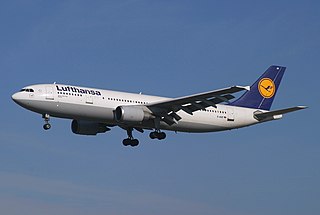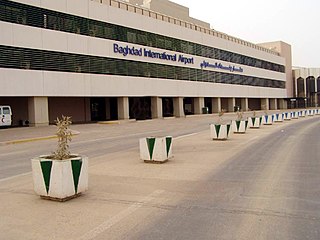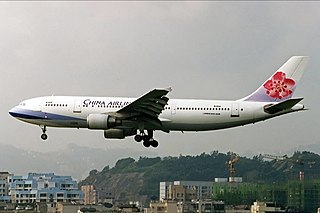
The Airbus A300 is Airbus's first production aircraft and the world's first twin-engine, double-aisle (wide-body) airliner, developed and manufactured by Airbus from 1971 to 2007.

American Airlines Flight 587 was a regularly scheduled international passenger flight from John F. Kennedy International Airport to Las Américas International Airport in Santo Domingo, the capital of the Dominican Republic. On November 12, 2001, the Airbus A300B4-605R flying the route crashed into the neighborhood of Belle Harbor on the Rockaway Peninsula of Queens, New York City, shortly after takeoff. All 260 people aboard the plane were killed, as well as five people on the ground. It is the second-deadliest aviation accident in U.S. history, behind the crash of American Airlines Flight 191 in 1979, and the second-deadliest aviation incident involving an Airbus A300, after Iran Air Flight 655.

Baghdad International Airport, previously Saddam International Airport from 1982 to 2003, is Iraq's largest international airport, located in a suburb about 16 km (9.9 mi) west of downtown Baghdad in the Baghdad Governorate. It is the home base for Iraq's national airline, Iraqi Airways.

The Airbus A310 is a wide-body aircraft, designed and manufactured by Airbus Industrie, then a consortium of European aerospace manufacturers. Airbus had identified a demand for an aircraft smaller than the A300, the first twin-jet wide-body. On 7 July 1978, the A310 was launched with orders from Swissair and Lufthansa. On 3 April 1982, the first prototype conducted its maiden flight, and the A310 received its type certificate on 11 March 1983.

United Airlines Flight 232 was a regularly scheduled United Airlines flight from Stapleton International Airport in Denver to O'Hare International Airport in Chicago, continuing to Philadelphia International Airport. On July 19, 1989, the DC-10 serving the flight crash-landed at Sioux Gateway Airport in Sioux City, Iowa, after suffering a catastrophic failure of its tail-mounted engine due to an unnoticed manufacturing defect in the engine's fan disk, which resulted in the loss of many flight controls. Of the 296 passengers and crew on board, 112 died during the accident, while 184 people survived. 13 of the passengers were uninjured. It was the deadliest single-aircraft accident in the history of United Airlines.
This is a list of aviation-related events from 1992.
This is a list of aviation-related events from 1997.

China Airlines Flight 676 was a scheduled international passenger flight. On Monday, 16 February 1998, the Airbus A300 jet airliner operating the flight crashed into a road and residential area in Tayuan, Taoyuan County, near Chiang Kai-shek International Airport, Taiwan.
In aviation, a phugoid or fugoid is an aircraft motion in which the vehicle pitches up and climbs, and then pitches down and descends, accompanied by speeding up and slowing down as it goes "downhill" and "uphill". This is one of the basic flight dynamics modes of an aircraft.
European Air Transport N.V./S.A. (EAT) was a cargo airline headquartered in Brussels Airport and in Zaventem, Belgium. The airline was owned by Deutsche Post and operated the group's DHL-branded parcel and express services in Europe.

China Airlines Flight 140 was a regularly scheduled passenger flight from Chiang Kai-shek International Airport to Nagoya Airport in Nagoya, Japan.

Garuda Indonesia Flight 152 (GA152/GIA152) was a scheduled domestic flight operated by Garuda Indonesia from Soekarno-Hatta International Airport, Tangerang, to Polonia International Airport, Medan, in Indonesia. On 26 September 1997, the aircraft flying the route crashed into mountainous woodlands near the village of Buah Nabar, Sibolangit, killing all 222 passengers and 12 crew members on board. It is the deadliest aviation disaster in Indonesia's history.

AeroUnion Flight 302, operated by an Airbus A300B4-203F cargo aircraft, crashed in poor weather on final approach at General Mariano Escobedo International Airport, Monterrey, Mexico around 23:18 CDT on 13 April 2010, after a flight from Mexico City. All five people on board were killed, as well as one on the ground.

Cathay Pacific Flight 780 was a flight from Juanda International Airport in Surabaya, Indonesia, to Hong Kong International Airport on 13 April 2010. On board were 309 passengers and a crew of 13. As Flight 780 neared Hong Kong, the crew were unable to change the thrust output of the engines. The aircraft, an Airbus A330-300, landed at almost twice the speed of a normal landing, suffering minor damage. The 57 passengers who sustained injuries were hurt in the ensuing slide evacuation; one of them received serious injuries.
Several aviation incidents and accidents have occurred in which the control surfaces of an aircraft became disabled, often due to failure of hydraulic systems or the flight control system. Other incidents have occurred where controls were not functioning correctly prior to take-off, either due to maintenance or pilot error, and controls can become inoperative from extreme weather conditions. Aircraft are not designed to be flown in such circumstances; however, a small number of pilots have had some success in flying and landing aircraft with disabled controls.
In aeronautics, loss of control (LOC) is the unintended departure of an aircraft from controlled flight and is a significant factor in several aviation accidents worldwide. In 2015 it was the leading cause of general aviation accidents. Loss of control may be the result of mechanical failure, external disturbances, aircraft upset conditions, or inappropriate crew actions or responses.

Malaysian Airline System Flight 684 (MH684/MAS684) was a scheduled international passenger flight of Malaysian Airline System from Singapore Changi Airport in Singapore to Subang International Airport, in Subang, Malaysia. On 18 December 1983, the Airbus A300B4-120 operating the flight crashed 2 km short of the runway while landing at Subang International Airport. There were no fatalities among the 247 passengers and crew.













